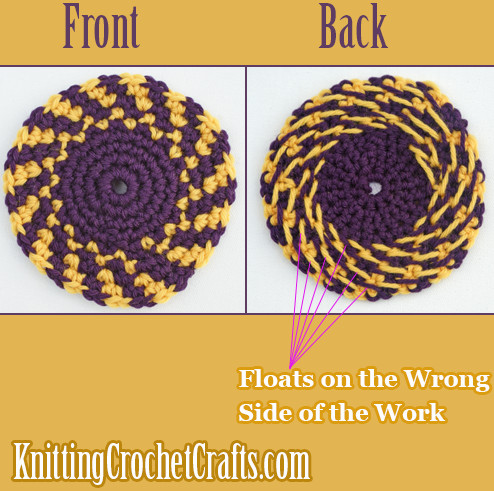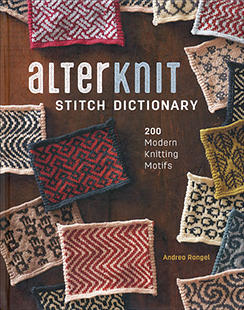What are floats? Learn the glossary definition for a float in knitting or crochet.

“Floats” is a term used in colorwork needlework techniques including Fair Isle knitting, stranded colorwork knitting and stranded colorwork crochet. This word describes unused strands of yarn, thread or fiber that are carried across the back of a piece due to a color change on the front of the work. This term is used in the same context by crochet enthusiasts, hand knitters, and machine knitters.
Depending on the project, floats can be problematic if they are too long.
Short floats are not a problem with items where the back of the project will not be exposed. A good example would be double-layered potholders, where you sew the wrong sides of the potholder together so they do not show. You still want to avoid excessively long floats, because they can cause your work to distort even if they won’t show on the right side of the work.
With projects where the back side of the work could come into contact with anything or anyone, long floats can create problems. It doesn’t matter if the floats are visible or not.
For example, you wouldn’t see the inside of a sweater that has floats. But, when you put the sweater on, the floats could catch on your jewelry, fingers, or shirt buttons.
Same thing with a purse or bag that has long floats. Anything you put in the bag could potentially get caught in the floats.
How to Prevent Long Floats in Crochet and Knitting
In crochet, long floats are easy to prevent. All you have to do is crochet overtop of the unused strands of yarn instead of stranding it across the back of the work. This technique is called “tapestry crochet.”
When you’re hand knitting, you prevent long floats by catching your unused yarns in the wrong side of the work every few stitches. This also helps to eliminate distorted work and gauge problems.
When you’re machine knitting with either simple punchcard or complex circular knitting machines, I’m not aware of any easy way to prevent long floats other than taking care not to work with, or design, patterns that have them. This was one of my most significant challenges when working as a circular knit fabric designer. My work with these machines focused on mass-market production for big box retailers, where hand manipulation of stitches was cost and time prohibitive. It is possible that there may be a way to hand manipulate machine knitted stitches to achieve this goal. Maybe — I’m not sure about this. So if you know of a way to do this, please do share it in the comments section.
How Long Is Too Long for Floats?
There is no universally correct answer to this question. I’ll share my own general guidelines, but these aren’t set in stone. Please take these into consideration, but feel free to use common sense to figure out what’s best for any particular project.
- For crochet, there are certain projects where I don’t like seeing any floats longer than a single stitch – scarves, shawls, and purses are good examples. (Your comfort zone here might vary, and that’s perfectly OK.)
- Then there are projects where I don’t mind floats of 2-3 stitches across the back of a piece. However, now that I know how to do tapestry crochet, I prefer crocheting overtop of the unused threads.
- When I took a machine knitting class at the Fashion Institute of Design and Merchandising, my instructor, Eliza Boughous, recommended that any wearable piece with floats of 6 or more stitches be given a lining. I think that’s good advice, but with crochet, there’s no reason to do this; if you crochet over the unused strands to start with, you avoid the problem of floats all together.
Learn More About Colorwork:

- Corner-to-Corner Crochet, a FAST Crochet Colorwork Technique You Need to Know About
- Learn Corner-to-Corner Crochet With Sarah Zimmerman’s Easy DVD Class
- Discover the Alterknit Stitch Dictionary Featuring Stranded Colorwork Knitting Patterns
- Handknits From Rauma, Norway: Scandinavian Knitting Pattern Designs
- Fair Isle Knitting Book: 22 Traditional Patterns from Where the Atlantic Meets the North Sea
More Crochet and Knitting Terms to Learn:

- Back Loops, Back Loop Only, or BLO in Crochet
- Crochet Hook vs Crochet Needle: Which Term Is Correct?
- Knitting and Crochet Abbreviations
Posted By: Amy Solovay
This page was last updated on 7-28-2023